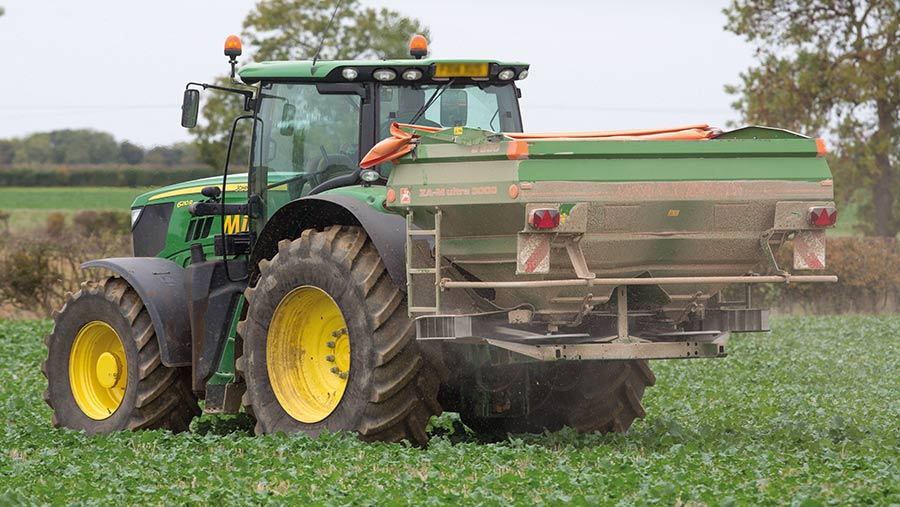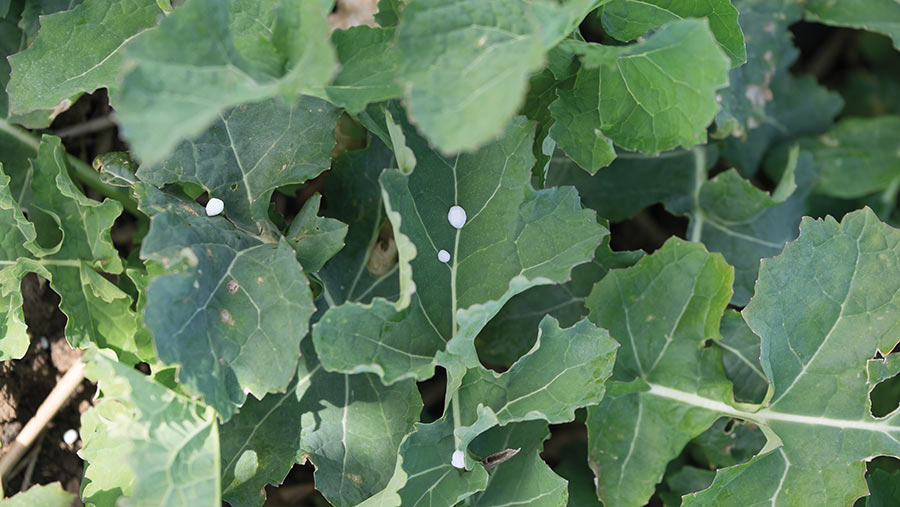How to get oilseed rape crop inputs right this spring
 Applying compound to OSR © Tim Scrivener
Applying compound to OSR © Tim Scrivener Striking the right balance between high input costs and fluctuating market prospects is the challenge for most oilseed rape growers this spring.
Crops should be assessed for their canopy size so that imminent nitrogen fertiliser applications can be fine-tuned before spring workloads are planned accordingly.
Expert advice is to start by estimating the soil nitrogen supply (SNS), which is the soil’s capacity to supply nitrogen, before looking to see how much is already in the crop.
See also: Why OSR growers are optimistic despite high-cost climate
Fertiliser savings
There is every chance that savings on fertiliser can be made this year, says Pete Berry, head of crop physiology at crop consultant Adas, who points out that large canopies are a sign that crops already contain good amounts of nitrogen – none of which gets wasted.
“That nitrogen stays there and gets used. These crops may look a bit scruffy for a while, but they do deliver with less nitrogen. If you aren’t brave enough to cut back on the whole crop, try a couple of tramlines,” he says.
Dr Berry refers to previous work and accepted wisdom that shows for each unit of green area index (GAI), there is 50kg of nitrogen/ha held in the crop.
“That’s nitrogen that you don’t need to apply. So an accurate assessment of both SNS and the canopy is well worth doing this year,” he adds.
If the crop is covering 50% of the ground, it has a GAI of 1, while 75% ground cover indicates a GAI of 2. “With nitrogen worth as much as £2/kg, a larger crop with a GAI of 3 already has £300 worth of nitrogen in it,” he says.
Break-even ratio

© Tim Scrivener
The price paid for the fertiliser and the market price for rapeseed also have a bearing, as they influence the break-even ratio (BER) – the kg of grain required to pay for 1kg of nitrogen.
While RB209 fertiliser guidance works on a BER of 2.5:1 for oilseed rape, recent price hikes and market volatility mean that this ratio is now around 4:1.
At that level, nitrogen rates should be reduced by 50kg of nitrogen/ha – a tweak that will only reduce yield by an average of 0.2t/ha.
“The most profitable rate of fertiliser to use will vary with prices, so that’s why the BER should be calculated for every crop. Make use of the AHDB calculator to help with this,” says Dr Berry.
Alice Andrews, independent agronomist at Ceres Rural, agrees with the principles of canopy measurement, but also places some of her spring fertiliser guidance on what crops look like in the field.
“It can be difficult to determine their yield potential at this stage, especially where cabbage stem flea beetle larvae are known to be present. By March, any damage they have inflicted will be obvious,” she says.
Having calculated the amount of nitrogen to be applied, growers then need to make the first application urgently. “Get it on now. Pigeons are starting to make their presence felt and we need to get crops growing away from them,” adds Mrs Andrews.
Crop passes
Reducing the number of passes through a crop in the spring may be possible, depending on circumstances. Three splits of nitrogen can come down to two, especially where canopies are large and smaller amounts of nitrogen are required.
While it is difficult to plan to make fewer passes, there is always potential. “It may be possible to combine the sclerotinia and light leaf spot sprays. But much will depend on the weather – it’s important to protect crops for the flowering period and that can be protracted if it’s dry,” she says.
There is also more light leaf spot disease being seen in crops than expected this year, some of which is variety-specific, but it is surprising given the recent sharp frosts..
“In some cases, there will have to be a dedicated light leaf spot application, even if you normally hold off until the sclerotinia timing. Be vigilant and monitor crops closely,” she adds.
Where micro-nutrients are in the plan, getting any tissue testing done 10 days before the fungicide timing will allow those applications to be combined.
Key points
- Estimate SNS and measure crop canopy to determine nitrogen requirement
- Calculate the BER before finalising nitrogen rates
- Remember the crop’s sulphur needs
- Monitor light leaf spot levels
- Don’t rely on herbicides to control large weeds
Sulphur requirements
Sulphur is always required by the oilseed rape crop and up to 80kg of SOз/ha is recommended, with 50kg/ha usually being right, says Dr Berry.
“Get it on early if possible. The focus should be sulphur – other micro-nutrient levels can be detected and corrected by using tissue testing,” says Mrs Andrews.
Where nitrogen inputs are being reduced, there is a risk that sulphur levels will fall too, as the two nutrients are often applied together, she says. While there are other options for getting sulphur into crops, it should be front of mind where nitrogen rates are coming down.
Any spring weed control actions will become obvious now that crops are opening up following the cold spell, says Joe Martin, arable herbicide field technical manager at Corteva Agriscience.
While the spring herbicide options are limited, products such as Korvetto (halauxifen-methyl + clopyralid) and Shield Pro (clopyralid) may have a place on weeds such as mayweed and poppy, both of which must be targeted while they are small.
“Applications can be made after 1 March. If corn marigold is the target then Shield Pro should be the product of choice,” he says.
Yield potential
Turning to cabbage stem flea beetle, Dr Berry says larvae numbers aren’t a great indicator of yield penalties. “Instead of a knee-jerk reaction to their numbers, make a judgement on how well the crop is growing,” he says.
Mrs Andrews agrees and emphasises the importance of protecting the crop from any other pressures and keeping it green, so that it grows away from any damage.
“It can be disheartening walking crops at this time of year. But much of the hard work has already been done and the spend has been made,” she says.
For these reasons, looking after the crop from here on makes sense. Given current crop values, the extra yield will more than compensate for additional costs, both Mrs Andrew and Dr Berry stress.
On insecticides, many growers have already made the decision not to spray for pests with improved integrated pest management (IPM) practices in place.
“That responsibility has been taken on by farmers. Insecticides are rarely used on the rape crop now – partly because they don’t work but also to avoid harming beneficials,” says Mrs Andrews.
Biostimulants
These products are an area of interest for the oilseed rape crop, but Adas results to date haven’t been consistent enough to make recommendations for using biostimulants.
Corteva’s BlueN can help to boost yields, says Mr Martin, but it needs to be applied to an actively growing crop that is unaffected by stress when temperatures have reached 10C.
“BlueN is a nutrient-efficiency biostimulant. It contains bacteria that help plants to capture nitrogen from the air throughout the season, reducing their dependency on uptake from the soil,” he adds.
You can also listen to the webcast How to balance high inputs and market prospects for OSR
What is OSR Future?
Corteva Agriscience is delighted to sponsor OSR Future, a series following the progress of the 2022-23 oilseed rape crop and exploring how farmers are changing the way they grow the crop.
OSR is a vital part of the rotation and Corteva remains committed to helping deliver the tools to ensure the crop has a bright future with farmers.
With an innovative R&D pipeline, fantastic varieties – such as sclerotinia-tolerant hybrid PT303 – alongside proven crop protection products, such as Belkar, Astrokerb, Kerb Flo 500 and Korvetto, farmers will be equipped with the tools they need to maximise the potential of their crops.

